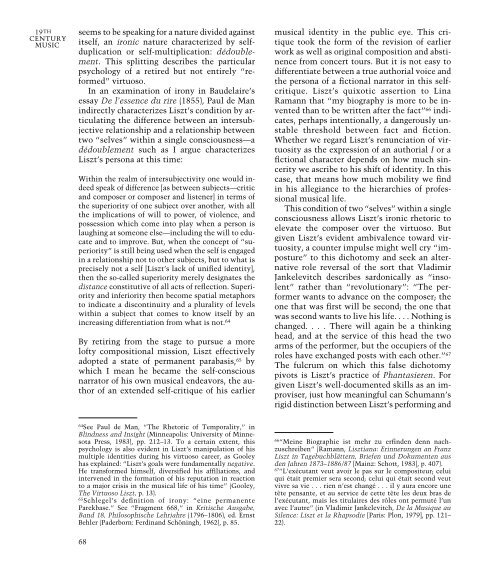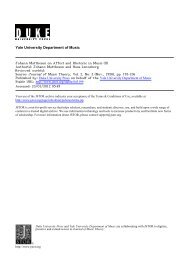19THCENTURYMUSICseems to be speaking for a nature divi<strong>de</strong>d againstitself, an ironic nature characterized by selfduplicationor self-multiplication: dédoublement.This splitting <strong>de</strong>scribes the particularpsychology of a retired but not entirely “reformed”virtuoso.In an examination of irony in Bau<strong>de</strong>laire’sessay De l’essence du rire (1855), Paul <strong>de</strong> Manindirectly characterizes <strong>Liszt</strong>’s condition by articulatingthe difference between an intersubjectiverelationship <strong>and</strong> a relationship betweentwo “selves” within a single consciousness—adédoublement such as I argue characterizes<strong>Liszt</strong>’s persona at this time:Within the realm of intersubjectivity one would in<strong>de</strong>edspeak of difference [as between subjects—critic<strong>and</strong> composer or composer <strong>and</strong> listener] in terms ofthe superiority of one subject over another, with allthe implications of will to power, of violence, <strong>and</strong>possession which come into play when a person islaughing at someone else—including the will to educate<strong>and</strong> to improve. But, when the concept of “superiority”is still being used when the self is engagedin a relationship not to other subjects, but to what isprecisely not a self [<strong>Liszt</strong>’s lack of unified i<strong>de</strong>ntity],then the so-called superiority merely <strong>de</strong>signates thedistance constitutive of all acts of reflection. Superiority<strong>and</strong> inferiority then become spatial metaphorsto indicate a discontinuity <strong>and</strong> a plurality of levelswithin a subject that comes to know itself by anincreasing differentiation from what is not. 64By retiring from the stage to pursue a morelofty compositional mission, <strong>Liszt</strong> effectivelyadopted a state of permanent parabasis, 65 bywhich I mean he became the self-consciousnarrator of his own musical en<strong>de</strong>avors, the authorof an exten<strong>de</strong>d self-critique of his earliermusical i<strong>de</strong>ntity in the public eye. This critiquetook the form of the revision of earlierwork as well as original composition <strong>and</strong> abstinencefrom concert tours. But it is not easy todifferentiate between a true authorial voice <strong>and</strong>the persona of a fictional narrator in this selfcritique.<strong>Liszt</strong>’s quixotic assertion to LinaRamann that “my biography is more to be inventedthan to be written after the fact” 66 indicates,perhaps intentionally, a dangerously unstablethreshold between fact <strong>and</strong> fiction.Whether we regard <strong>Liszt</strong>’s renunciation of virtuosityas the expression of an authorial I or afictional character <strong>de</strong>pends on how much sinceritywe ascribe to his shift of i<strong>de</strong>ntity. In thiscase, that means how much mobility we findin his allegiance to the hierarchies of professionalmusical life.This condition of two “selves” within a singleconsciousness allows <strong>Liszt</strong>’s ironic rhetoric toelevate the composer over the virtuoso. Butgiven <strong>Liszt</strong>’s evi<strong>de</strong>nt ambivalence toward virtuosity,a counter impulse might well cry “imposture”to this dichotomy <strong>and</strong> seek an alternativerole reversal of the sort that VladimirJankelevitch <strong>de</strong>scribes sardonically as “insolent”rather than “revolutionary”: “The performerwants to advance on the composer; theone that was first will be second; the one thatwas second wants to live his life. . . . Nothing ischanged. . . . There will again be a thinkinghead, <strong>and</strong> at the service of this head the twoarms of the performer, but the occupiers of theroles have exchanged posts with each other.” 67The fulcrum on which this false dichotomypivots is <strong>Liszt</strong>’s practice of Phantasieren. Forgiven <strong>Liszt</strong>’s well-documented skills as an improviser,just how meaningful can Schumann’srigid distinction between <strong>Liszt</strong>’s performing <strong>and</strong>64See Paul <strong>de</strong> Man, “The Rhetoric of Temporality,” inBlindness <strong>and</strong> Insight (Minneapolis: University of MinnesotaPress, 1983), pp. 212–13. To a certain extent, thispsychology is also evi<strong>de</strong>nt in <strong>Liszt</strong>’s manipulation of hismultiple i<strong>de</strong>ntities during his virtuoso career, as Gooleyhas explained: “<strong>Liszt</strong>’s goals were fundamentally negative.He transformed himself, diversified his affiliations, <strong>and</strong>intervened in the formation of his reputation in reactionto a major crisis in the musical life of his time” (Gooley,The Virtuoso <strong>Liszt</strong>, p. 13).65Schlegel’s <strong>de</strong>finition of irony: “eine permanenteParekbase.” See “Fragment 668,” in Kritische Ausgabe,B<strong>and</strong> 18, Philosophische Lehrjahre (1796–1806), ed. ErnstBehler (Pa<strong>de</strong>rborn: Ferdin<strong>and</strong> Schöningh, 1962), p. 85.66“Meine Biographie ist mehr zu erfin<strong>de</strong>n <strong>de</strong>nn nachzuschreiben”(Ramann, <strong>Liszt</strong>iana: Erinnerungen an Franz<strong>Liszt</strong> in Tagebuchblättern, Briefen und Dokumenten aus<strong>de</strong>n Jahren 1873–1886/87 [Mainz: Schott, 1983], p. 407).67“L’exécutant veut avoir le pas sur le compositeur; celuiqui était premier sera second; celui qui était second veutvivre sa vie . . . rien n’est changé . . . il y aura encore <strong>une</strong>tête pensante, et au service <strong>de</strong> cette tête les <strong>de</strong>ux bras <strong>de</strong>l’exécutant, mais les titulaires <strong>de</strong>s rôles ont permuté l’unavec l’autre” (in Vladimir Jankelevitch, De la Musique auSilence: <strong>Liszt</strong> et la Rhapsodie [Paris: Plon, 1979], pp. 121–22).68
composing be before the latter’s move toWeimar? 68Jankelevitch took this entanglement of action<strong>and</strong> i<strong>de</strong>ntity to its reductio ad absurdumwhen he protested: “It would be necessary tosay that virtuosic music is a music withoutcomposer.” 69 In this abstract reading of keyboardvirtuosity, the “thinking head” controllingthe fingers can belong—in different ways—to either a performer or composer. But if thesefigures occupy the poles of a continuum, thecontinuum is asymmetrical: only the mobilevirtuoso is capable of traversing the span ofpossibilities in either direction, even to thepoint of usurping either pole. Thus the dichotomyof performer <strong>and</strong> composer becomesfalse in the context of <strong>Liszt</strong>ian virtuosity.To what extent does the biographical evi<strong>de</strong>ncesupport the view that <strong>Liszt</strong> himself observed,or at least acted on, this recognition?George S<strong>and</strong>’s diary reports that as a touringvirtuoso <strong>Liszt</strong> wrote his music directly at thepiano. S<strong>and</strong> <strong>de</strong>scribes his labors on a new projectat Nohant in 1837: “Perhaps it is some compositionaltask that he [<strong>Liszt</strong>] tries out in fragmentsat the piano; besi<strong>de</strong> him is his pipe, hisruled paper <strong>and</strong> quill pens. . . . It seems to methat while passing before the piano he must bechurning out these capricious phrases unconsciouslyobedient to his instinct of feeling ratherthan to the labor of reason.” 70 While it is not68By way of historical evi<strong>de</strong>nce for <strong>Liszt</strong>’s improvisations,the journal Le Corsaire, reflecting the typical reception of<strong>Liszt</strong>’s concert etiquette, records that, after listening to atrio for cello, piano, <strong>and</strong> oboe: “<strong>Liszt</strong>’s natural impulsesthen took over, <strong>and</strong> he rushed towards the piano <strong>de</strong>spitehimself, took one of the motifs from the trio just executed,varied it, <strong>and</strong> gave it a new charm . . . every transfixedlistener thought himself transported by a dream into aplace inhabited by the god of harmony.” Thereafter LeCorsaire referred to <strong>Liszt</strong> as the “famous improviser.” SeeMaurice Henri Cecourcelle, La Société académiques <strong>de</strong>senfants d’Apollon (Paris: Schoenewerk & cie, 1881), p.137.69“Il faudrait dire . . . que la musique virtuose est <strong>une</strong>musique sans compositeur” (Jankelevitch, <strong>Liszt</strong> et laRhapsodie, p. 122).70“C’est peut-être un travail <strong>de</strong> composition qu’il essayepar fragments sur le piano; à côté <strong>de</strong> lui est sa pipe, sonpapier réglé et ses plumes . . . Il me semble qu’en passant<strong>de</strong>vant son piano, il doit jeter ces phrases capricieuses àson insu en obéissant à son instinct <strong>de</strong> sentiment plutôtqu’à un travail d’intelligence” (George S<strong>and</strong>, “Entretiensjournaliers,” in Œuvres autobiographiques, ed. GeorgesLubin, 2 vols. [Paris: Gallimard, 1971], II, 981).uncommon for composers to work at, or atleast within reach of, a piano, <strong>Liszt</strong> had honed<strong>and</strong> <strong>de</strong>veloped his instinctive abilities at thekeyboard to the extent that he seemed able toimprovise a passage rapidly on specific musicalmaterial 71 without feeling bound by whatHaydn—in the context of improvisation—hadcalled “the rules of art.” 72 By beginning withphysical performance, <strong>Liszt</strong> could generate animmediate realization of the music, producingmusical passages first as sonic objects ratherthan as intentional objects. This practice mayhave led the “Dante” Sonata—charged by onecritic in 1887, we may recall, as lacking any“<strong>de</strong>finite meaning in the constant progressionof discords”—to fall victim to <strong>Liszt</strong>’s own earliercapacity for Phantasieren. Schumann anticipatedthis situation with sly irony when he71This probably gave <strong>Liszt</strong> the freedom to realize instantlycertain particular textures of harmony, counterpoint,melody, <strong>and</strong> rhythm, or the lack thereof (Rosen’s “zero<strong>de</strong>gree of musical invention”), presenting the sound imageof a virtuoso performance at the point of the music’s inception.At the end of his Clavierschule, Hummel’s commentson improvisation lend cre<strong>de</strong>nce to this view. Aprerequisite for free Phantasieren, he asserts, is that “theh<strong>and</strong>s perform what the mind thinks without constraintregardless of which key the player is in, <strong>and</strong> to be precise,[they] perform without needing to be clearly conscious ofthe mechanical actions” (die Hän<strong>de</strong> ohne Zwang, gleichvielin welcher Tonart sich <strong>de</strong>r Spieler befin<strong>de</strong>t, das ausführen,was <strong>de</strong>r Geist <strong>de</strong>nkt, und zwar es ausführen, ohne dass es<strong>de</strong>s klaren Bewusstseins über diese mechanischenVerrichtungen bedarf). It is precisely this skill that <strong>Liszt</strong>relied on in part—I am suggesting—when “composing” atthe piano during the later 1830s. See Johann NepomukHummel, Ausführliche theoretisch-practische Anweisungzum Piano-Forte-Spiel, vol. 3 (Vienna: Tobias Haslinger,1828), p. 444. For a cultural study of the intersection <strong>and</strong>correspon<strong>de</strong>nces between doctrines of sensation <strong>and</strong> pedagogicalpiano methods in the late eighteenth <strong>and</strong> the earlynineteenth century, see Leslie David Blasius, “The Mechanicsof Sensation <strong>and</strong> the Construction of the RomanticMusical Experience,” in Music Theory in the Age ofRomanticism, ed. Ian Bent (Cambridge: Cambridge UniversityPress, 1996), pp. 3–24.72Reading “rules” as synonymous with “formal procedure”in this context further distinguishes <strong>Liszt</strong>’s attitu<strong>de</strong> tofantasy improvisation from late-eighteenth-century extemporepractice, for which adherence to certain “rules”seemed <strong>de</strong> rigueur. Haydn’s full statement reads: “I satdown, began to improvise, sad or happy according to mymood, serious or trifling. Once I had seized upon an i<strong>de</strong>a,my whole en<strong>de</strong>avor was to <strong>de</strong>velop <strong>and</strong> sustain it in keepingwith the rules of art” (Georg August Griesinger,Biographische Notizen über Joseph Haydn [Leipzig:Breitkopf <strong>and</strong> Härtel, 1810], trans. Vernon Gotwals, Haydn:Two Contemporary Portraits [Madison: University of WisconsinPress, 1963], p. 61).DAVIDTRIPPETT<strong>Virtuosity</strong> inthe “Dante”Sonata69



